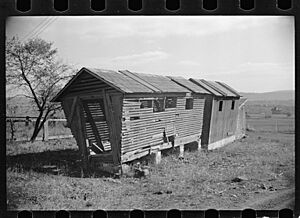Corn crib facts for kids
A corn crib is a special building or bin used to dry and store corn. People also call it a cornhouse. It's designed to keep the corn fresh and safe after it's picked from the field.
How Corn Cribs Work
After farmers pick corn, they put it into a corn crib. The corn is usually still on its cob, and sometimes it still has its outer leaves, called husks. Corn cribs have special walls with gaps or slats. These gaps let air flow all around the corn. This helps the corn dry out and stops it from getting moldy.
Because the walls have gaps, corn cribs are built high off the ground. This helps keep hungry animals like mice and rats from reaching the corn.
History of Corn Cribs
People all over the world have used buildings called granaries to store grain for a long time. But corn cribs were first used by Native Americans. European settlers who came to America quickly learned about them and started using them too.
Sometimes, early European settlers who were struggling for food would take corn from Native American corn cribs. Because of this, some Native American groups started burying their food in hidden spots instead of storing it in cribs.
Different Kinds of Corn Cribs
Corn cribs come in many different shapes and sizes. They were first made from wood, but later, people also used materials like concrete.
A simple corn crib is a bin with a roof, raised up on posts. Another early design in America had walls that slanted outwards. Many larger corn cribs have an open space in the middle. This space helps air move around the corn even better. Sometimes, this middle area was even used to store farm wagons.
By the early 1900s, the name "corn crib" also referred to large barns that held many separate bins of corn. Today, on many farms, a typical corn crib looks like a round cage made of metal wire fencing. It usually has a metal roof made of wavy, galvanized iron sheets.

Gallery








